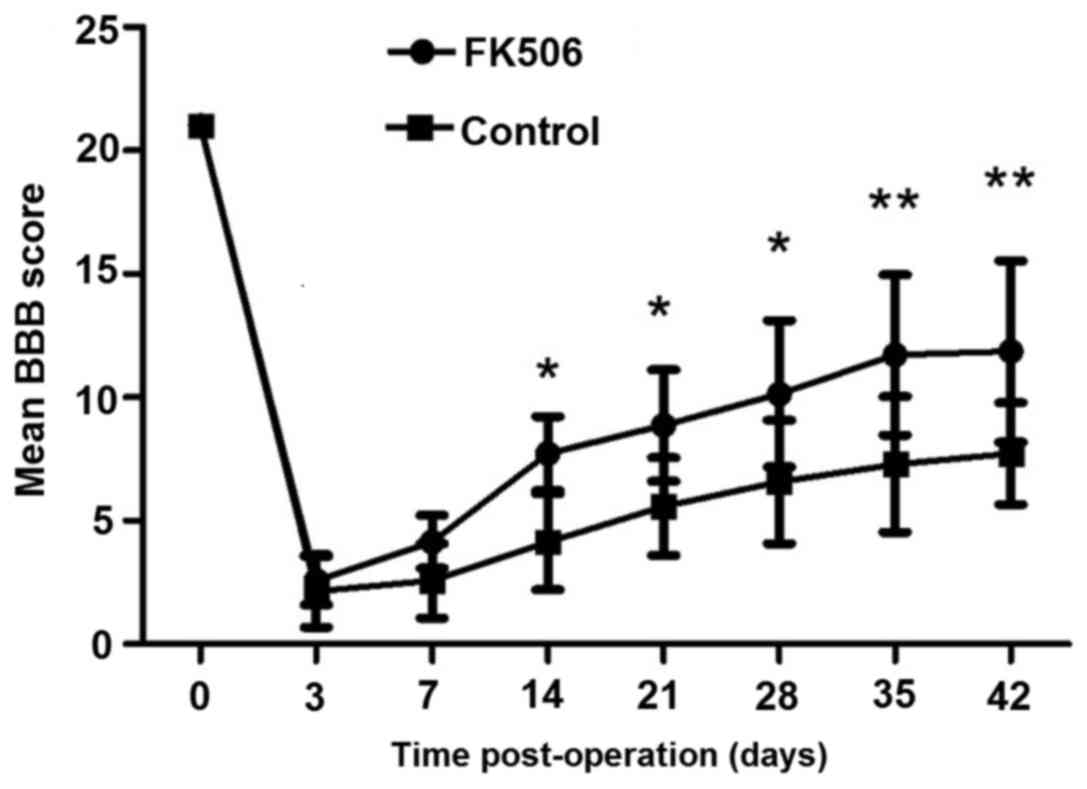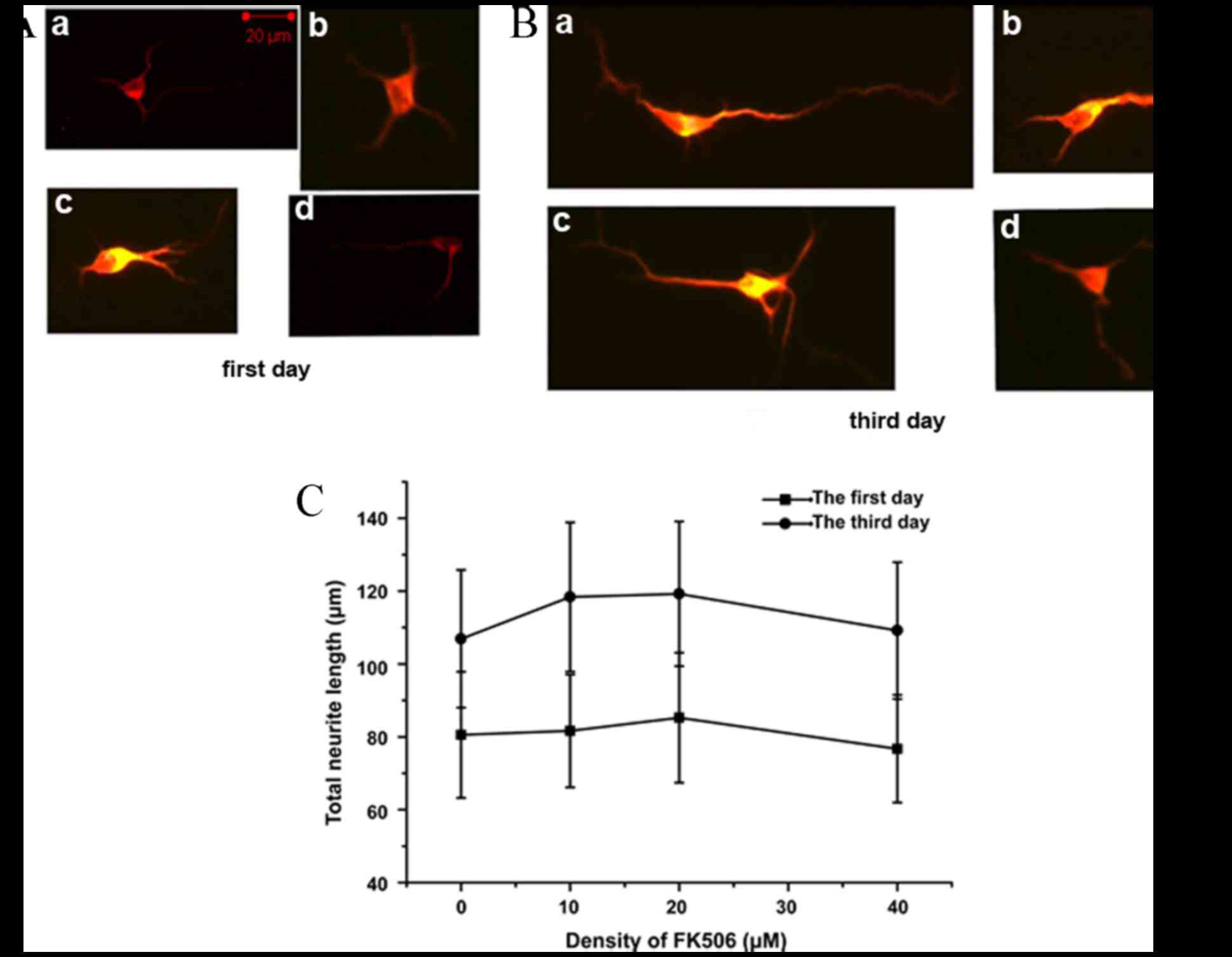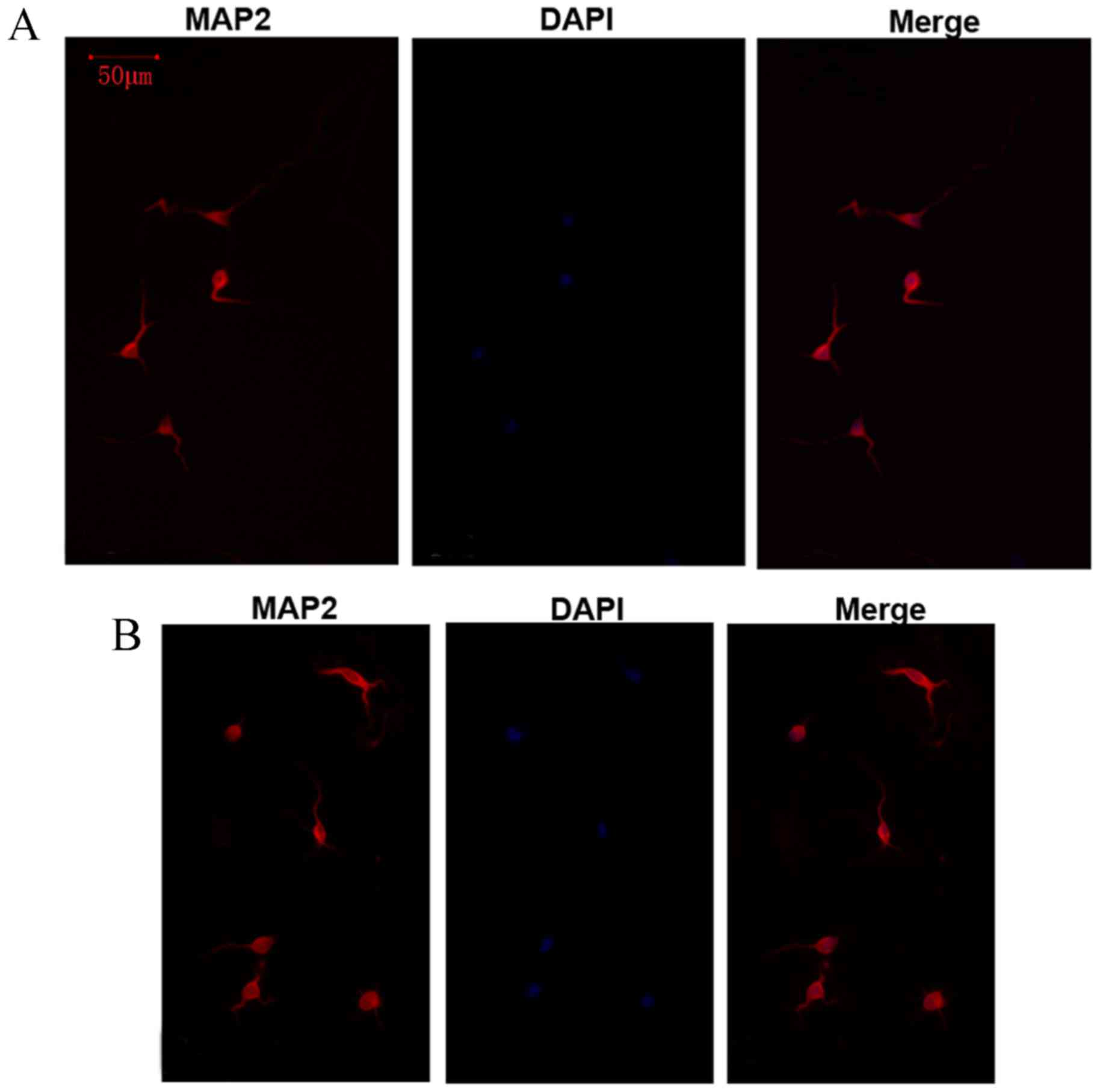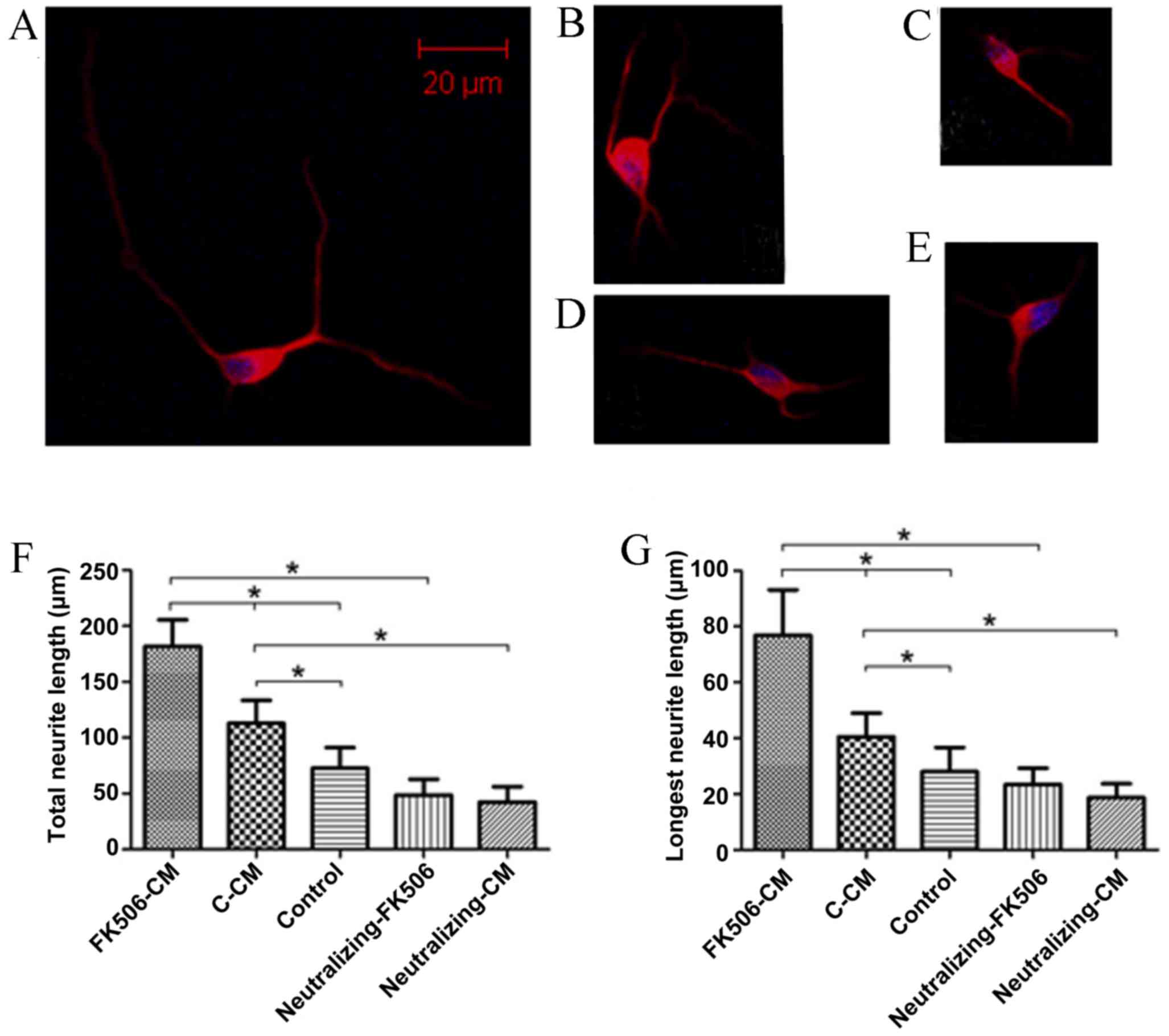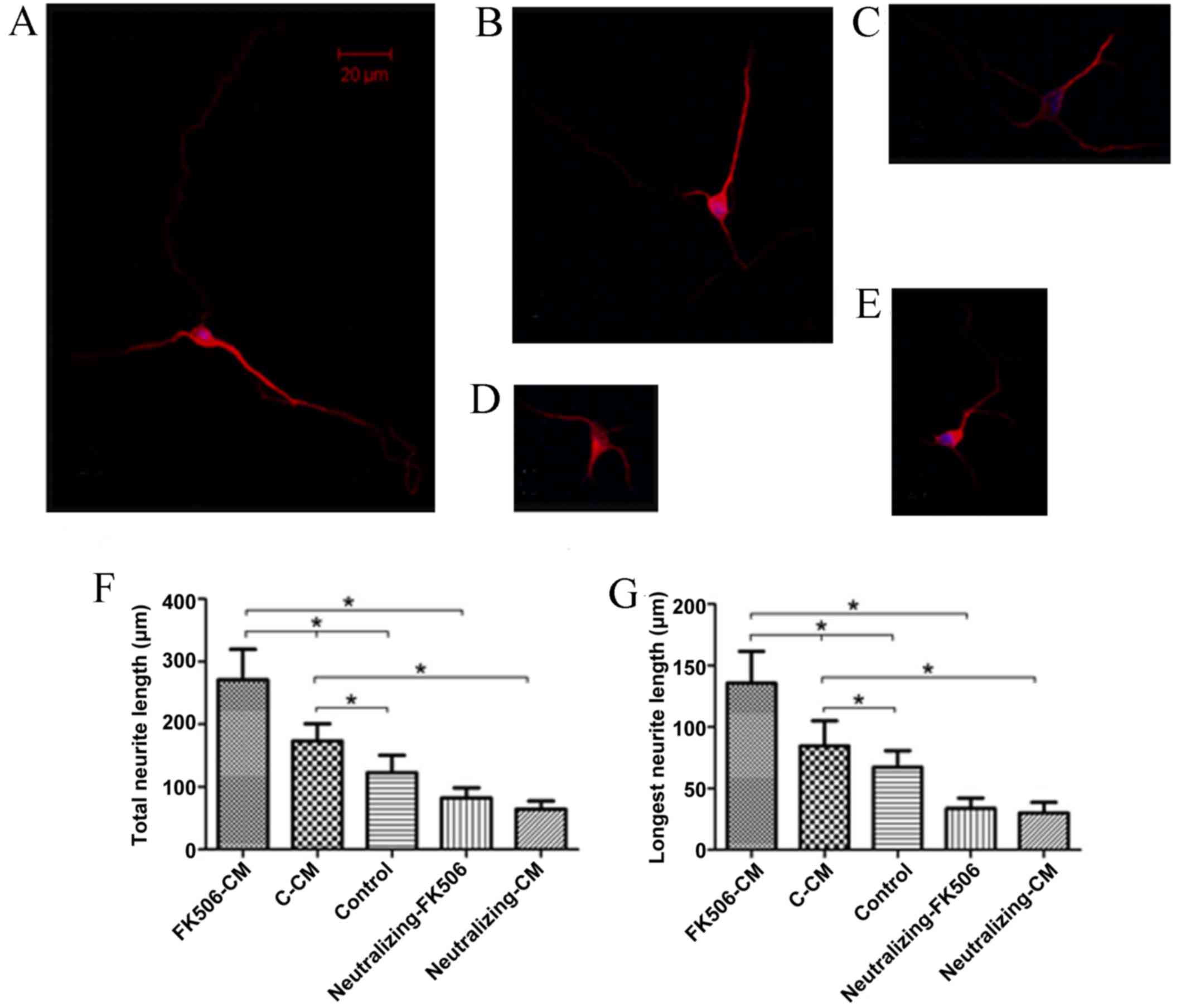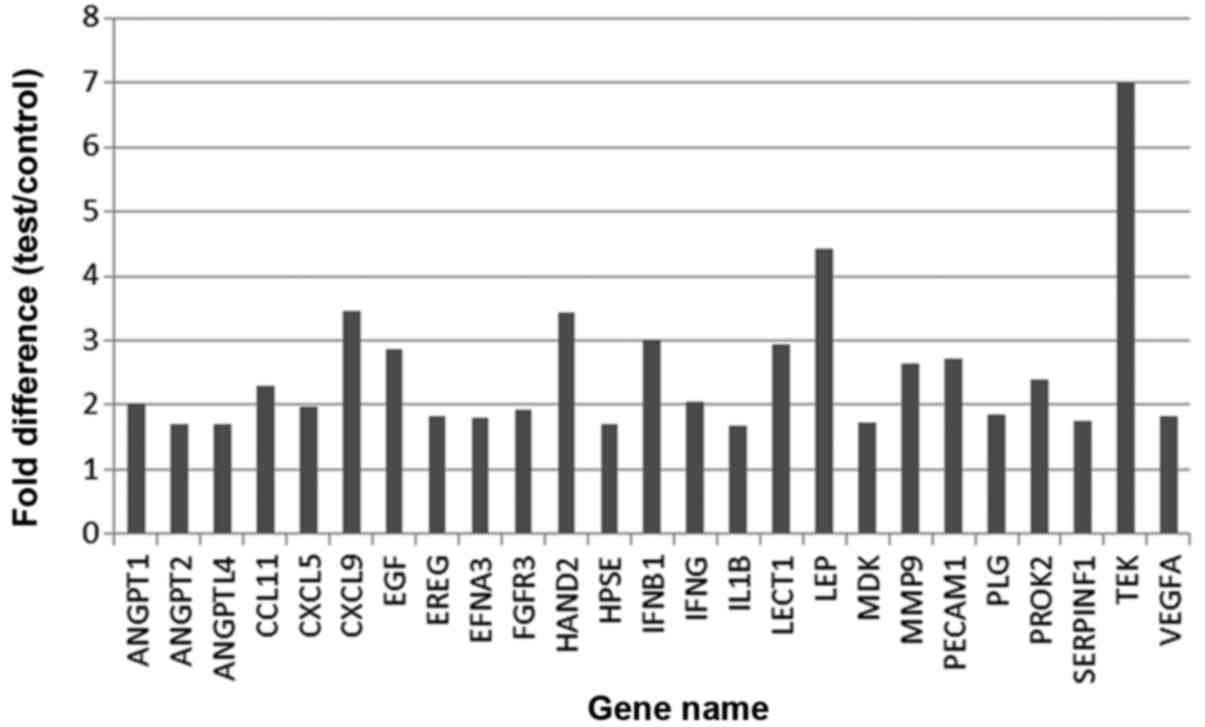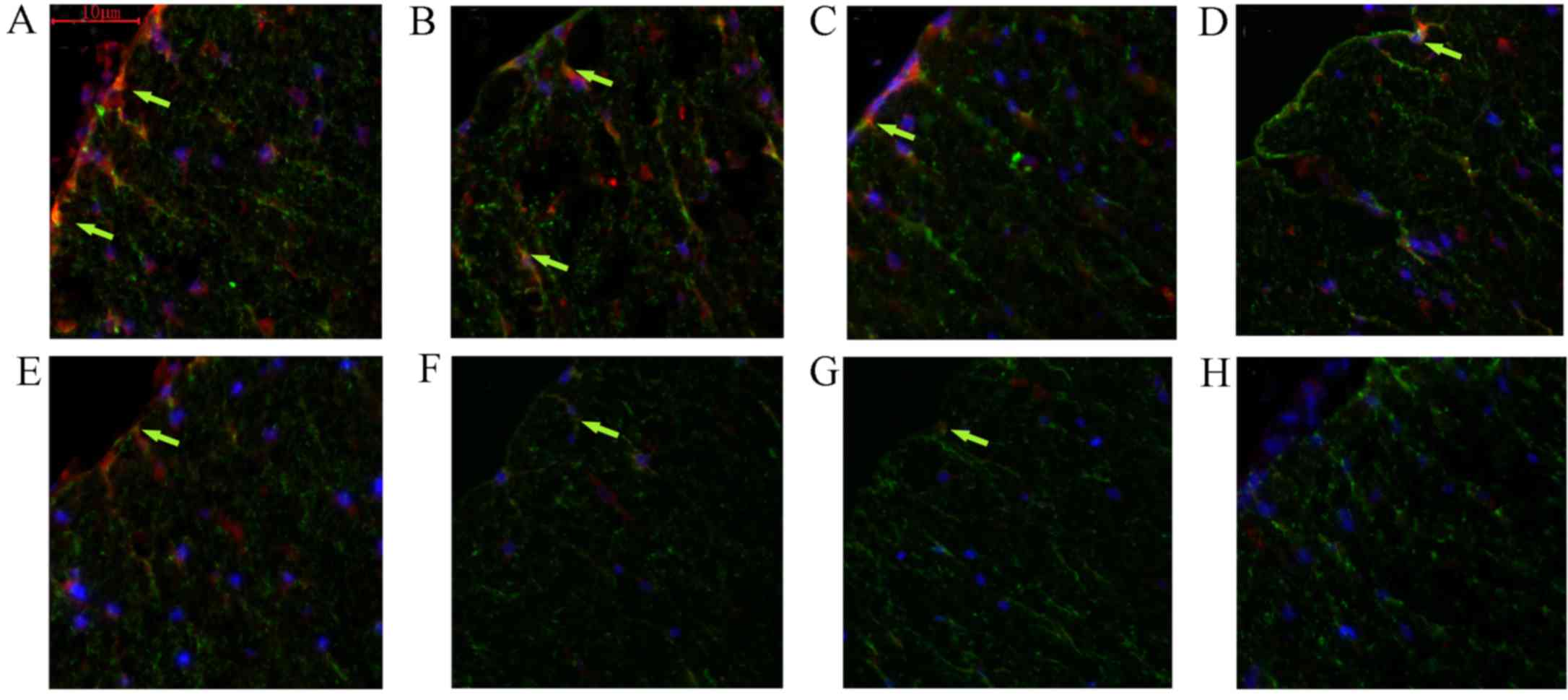|
1
|
Ibarra A and Martiñón S: Pharmacological
approaches to induce neuroregeneration in spinal cord injury: An
overview. Curr Drug Discov Technol. 6:82–90. 2009. View Article : Google Scholar : PubMed/NCBI
|
|
2
|
Baptiste DC and Fehlings MG: Update on the
treatment of spinal cord injury. Prog Brain Res. 161:217–233. 2007.
View Article : Google Scholar : PubMed/NCBI
|
|
3
|
Faulkner JR, Herrmann JE, Woo MJ, Tansey
KE, Doan NB and Sofroniew MV: Reactive astrocytes protect tissue
and preserve function after spinal cord injury. J Neurosci.
24:2143–2155. 2004. View Article : Google Scholar : PubMed/NCBI
|
|
4
|
Davies S, Shih CH, Noble M, Mayer-Proschel
M, Davies JE and Proschel C: Transplantation of specific human
astrocytes promotes functional recovery after spinal cord injury.
PLoS One. 6:e173282011. View Article : Google Scholar : PubMed/NCBI
|
|
5
|
Staatz CE and Tett SE: Clinical
pharmacokinetics and pharmacodynamics of tacrolimus in solid organ
transplantation. Clin Pharmacokinet. 43:623–653. 2004. View Article : Google Scholar : PubMed/NCBI
|
|
6
|
Klettner A and Herdegen T: FK506 and its
analogs-therapeutic potential for neurological disorders. Curr Drug
Targets CNS Neurol Disord. 2:153–162. 2003. View Article : Google Scholar : PubMed/NCBI
|
|
7
|
Sosa I, Reyes O and Kuffler D:
Immunosuppressants: Neuroprotection and promoting neurological
recovery following peripheral nerve and spinal cord lesions. Exp
Neurol. 195:7–15. 2005. View Article : Google Scholar : PubMed/NCBI
|
|
8
|
Wildering WC, Hermann PM and Bulloch AG:
Lymnaea epidermal growth factor promotes axonal regeneration in CNS
organ culture. J Neurosci. 21:9345–9354. 2001. View Article : Google Scholar : PubMed/NCBI
|
|
9
|
Liberto CM, Albrecht PJ, Herx LM, Yong VW
and Levison SW: Pro-regenerative properties of cytokine-activated
astrocytes. J Neurochem. 89:1092–1100. 2004. View Article : Google Scholar : PubMed/NCBI
|
|
10
|
Kuh SU, Cho YE, Yoon DH, Kim KN and Ha Y:
Functional recovery after human umbilical cord blood cells
transplantation with brain-derived neutrophic factor into the
spinal cord injured rat. Acta Neurochir (Wien). 147:985–992. 2005.
View Article : Google Scholar : PubMed/NCBI
|
|
11
|
Young W: Spinal cord regeneration.
Science. 273:4511996. View Article : Google Scholar : PubMed/NCBI
|
|
12
|
Basso DM, Beattie MS and Bresnahan JC: A
sensitive and reliable locomotor rating scale for open field
testing in rats. J Neurotrauma. 12:1–21. 1995. View Article : Google Scholar : PubMed/NCBI
|
|
13
|
Zhang A, Zhang J, Sun P, Yao C, Su C, Sui
T, Huang H, Cao X and Ge Y: EIF2alpha and caspase-12 activation are
involved in oxygen-glucose-serum deprivation/restoration-induced
apoptosis of spinal cord astrocytes. Neurosci Lett. 478:32–36.
2010. View Article : Google Scholar : PubMed/NCBI
|
|
14
|
Iyer VR, Eisen MB, Ross DT, Schuler G,
Moore T, Lee JC, Trent JM, Staudt LM, Hudson J Jr, Boguski MS, et
al: The transcriptional program in the response of human
fibroblasts to serum. Science. 283:83–87. 1999. View Article : Google Scholar : PubMed/NCBI
|
|
15
|
Livak KJ and Schmittgen TD: Analysis of
relative gene expression data using real-time quantitative PCR and
the 2(-Delta Delta C(T)) method. Methods. 25:402–408. 2001.
View Article : Google Scholar : PubMed/NCBI
|
|
16
|
Liu N, Li H, Liu K, Yu J, Cheng M, De W,
Liu J, Shi S, He Y and Zhao J: Differential expression of genes and
proteins associated with wool follicle cycling. Mol Biol Rep.
41:5343–5349. 2014. View Article : Google Scholar : PubMed/NCBI
|
|
17
|
Cai J, Zhao XL, Liu AW, Nian H and Zhang
SH: Apigenin inhibits hepatoma cell growth through alteration of
gene expression patterns. Phytomedicine. 18:366–373. 2011.
View Article : Google Scholar : PubMed/NCBI
|
|
18
|
Gezginci-Oktayoglu S, Karatug A and
Bolkent S: The relation among NGF, EGF and insulin is important for
triggering pancreatic β cell apoptosis. Diabetes Metab Res Rev.
28:654–662. 2012. View Article : Google Scholar : PubMed/NCBI
|
|
19
|
Han SS, Kang DY, Mujtaba T, Rao MS and
Fischer I: Grafted lineage-restricted precursors differentiate
exclusively into neurons in the adult spinal cord. Exp Neurol.
177:360–375. 2002. View Article : Google Scholar : PubMed/NCBI
|
|
20
|
Gomes FC, Maia CG, de Menezes JR and Neto
VM: Cerebellar astrocytes treated by thyroid hormone modulate
neuronal proliferation. Glia. 25:247–255. 1999. View Article : Google Scholar : PubMed/NCBI
|
|
21
|
Stipursky J and Gomes FC: TGF-beta1/SMAD
signaling induces astrocyte fate commitment in vitro: Implications
for radial glia development. Glia. 55:1023–1033. 2007. View Article : Google Scholar : PubMed/NCBI
|
|
22
|
Spohr E TC, Dezonne RS, Rehen SK and Gomes
FC: Astrocytes treated by lysophosphatidic acid induce axonal
outgrowth of cortical progenitors through extracellular matrix
protein and epidermal growth factor signaling pathway. J Neurochem.
119:113–123. 2011. View Article : Google Scholar : PubMed/NCBI
|
|
23
|
Voda J, Yamaji T and Gold BG:
Neuroimmunophilin ligands improve functional recovery and increase
axonal growth after spinal cord hemisection in rats. J Neurotrauma.
22:1150–1161. 2005. View Article : Google Scholar : PubMed/NCBI
|
|
24
|
Yeh C, Bowers D and Hadlock TA: Effect of
FK506 on functional recovery after facial nerve injury in the rat.
Arch Facial Plast Surg. 9:333–339. 2007. View Article : Google Scholar : PubMed/NCBI
|
|
25
|
López-Vales R, García-Alías G, Forés J,
Udina E, Gold BG, Navarro X and Verdú E: FK506 reduces tissue
damage and prevents functional deficit after spinal cord injury in
the rat. J Neurosci Res. 81:827–836. 2005. View Article : Google Scholar : PubMed/NCBI
|
|
26
|
Udina E, Ceballos D, Verdú E, Gold BG and
Navarro X: Bimodal dose-dependence of FK506 on the rate of axonal
regeneration in mouse peripheral nerve. Muscle Nerve. 26:348–355.
2002. View Article : Google Scholar : PubMed/NCBI
|
|
27
|
Gold BG, Densmore V, Shou W, Matzuk MM and
Gordon HS: Immunophilin FK506-binding protein 52 (not FK506-binding
protein 12) mediates the neurotrophic action of FK506. J Pharmacol
Exp Ther. 289:1202–1210. 1999.PubMed/NCBI
|
|
28
|
Buffo A, Rolando C and Ceruti S:
Astrocytes in the damaged brain: Molecular and cellular insights
into their reactive response and healing potential. Biochem
Pharmacol. 79:77–89. 2010. View Article : Google Scholar : PubMed/NCBI
|
|
29
|
Bush TG, Puvanachandra N, Horner CH,
Polito A, Ostenfeld T, Svendsen CN, Mucke L, Johnson MH and
Sofroniew MV: Leukocyte infiltration, neuronal degeneration, and
neurite outgrowth after ablation of scar-forming, reactive
astrocytes in adult transgenic mice. Neuron. 23:297–308. 1999.
View Article : Google Scholar : PubMed/NCBI
|
|
30
|
Szydlowska K, Gozdz A, Dabrowski M,
Zawadzka M and Kaminska B: Prolonged activation of ERK triggers
glutamate-induced apoptosis of astrocytes: Neuroprotective effect
of FK506. J Neurochem. 113:904–918. 2010. View Article : Google Scholar : PubMed/NCBI
|
|
31
|
Szydlowska K, Zawadzka M and Kaminska B:
Neuroprotectant FK506 inhibits glutamate-induced apoptosis of
astrocytes in vitro and in vivo. J Neurochem. 99:965–975. 2006.
View Article : Google Scholar : PubMed/NCBI
|
|
32
|
Kahraman S, Bambrick LL and Fiskum G:
Effects of FK506 and cyclosporin a on calcium ionophore-induced
mitochondrial depolarization and cytosolic calcium in astrocytes
and neurons. J Neurosci Res. 89:1973–1978. 2011. View Article : Google Scholar : PubMed/NCBI
|
|
33
|
Wong RW and Guillaud L: The role of
epidermal growth factor and its receptors in mammalian CNS.
Cytokine Growth Factor Rev. 15:147–156. 2004. View Article : Google Scholar : PubMed/NCBI
|
|
34
|
Fricker-Gates RA, Winkler C, Kirik D,
Rosenblad C, Carpenter MK and Bjorklund A: EGF infusion stimulates
the proliferation and migration of embryonic progenitor cells
transplanted in the adult rat striatum. Exp Neurol. 165:237–247.
2000. View Article : Google Scholar : PubMed/NCBI
|
|
35
|
Yamada M, Ikeuchi T and Hatanaka H: The
neurotrophic action and signalling of epidermal growth factor. Prog
Neurobiol. 51:19–37. 1997. View Article : Google Scholar : PubMed/NCBI
|
|
36
|
Goldshmit Y, Greenhalgh CJ and Turnley AM:
Suppressor of cytokine signalling-2 and epidermal growth factor
regulate neurite outgrowth of cortical neurons. Eur J Neurosci.
20:2260–2266. 2004. View Article : Google Scholar : PubMed/NCBI
|
|
37
|
Martinez R and Gomes FC: Neuritogenesis
induced by thyroid hormone-treated astrocytes is mediated by
epidermal growth factor/mitogen-activated protein
kinase-phosphatidylinositol 3-kinase pathways and involves
modulation of extracellular matrix proteins. J Biol Chem.
277:49311–49318. 2002. View Article : Google Scholar : PubMed/NCBI
|
|
38
|
Xiang YY, Dong H, Wan Y, Li J, Yee A, Yang
BB and Lu WY: Versican G3 domain regulates neurite growth and
synaptic transmission of hippocampal neurons by activation of
epidermal growth factor receptor. J Biol Chem. 281:19358–19368.
2006. View Article : Google Scholar : PubMed/NCBI
|
|
39
|
Zawadzka M and Kaminska B:
Immunosuppressant FK506 affects multiple signaling pathways and
modulates gene expression in astrocytes. Mol Cell Neurosci.
22:202–209. 2003. View Article : Google Scholar : PubMed/NCBI
|



